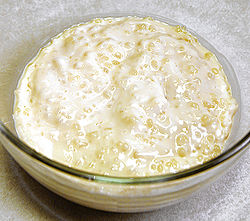Varieties
The pudding can be made from scratch using tapioca in a variety of forms: flakes, coarse meal, sticks, and pearls. Many commercial packaged mixes are also available. [2]
Ingredients served alongside and put into tapioca pudding have varied over time. An American style of tapioca pudding in the 19th century was known to contain no sugar within the pudding itself but would be served with sugar and cream on the side. [3] By contrast, some recipes that circulated through the British Empire during the 18th century were known to season their tapioca with cinnamon, red wine, and even bone marrow. [4]
History
A significant reason for tapioca pudding's popularity was the ease of access in acquiring tapioca balls compared to its alternative, sago. Tapioca pearls originate from the harvesting of the cassava plant, which required less labor to harvest and grew faster compared to sago. [5] Tapioca pudding would become a prominent staple of the lunches of school children in western countries such as Britain, Australia, and the United States. [5]
British schoolchildren have traditionally nicknamed the dish frog spawn due to its appearance. [6] The Guardian described it as "Britain's most hated school pudding" with names such as fisheyes, frogspawn, and eyeball pudding. It is, however, making a comeback in the 21st century in Michelin-starred restaurants and less exalted places. [2]
In southern India, a type of dessert pudding known as jawhuarusee payasam made from tapioca pearls is made during festival times.
Tapioca pudding was one of the dishes that Rhode Island army officers ate for their Fourth of July celebrations during the siege of Petersburg. [7]
In the United Kingdom, July 16th is recognized as National Tapioca Pudding Day. [8]
This page is based on this
Wikipedia article Text is available under the
CC BY-SA 4.0 license; additional terms may apply.
Images, videos and audio are available under their respective licenses.
